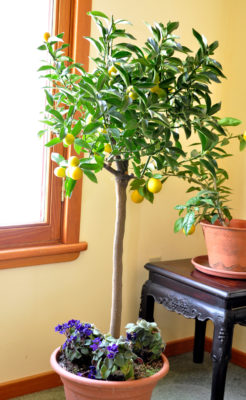LOOK BEYOND POINSETTIA GLITZ
/8 Comments/in Houseplants/by Lee ReichA Harem of Males
Phew, what a year 2020 was! Well, it’s over and, at least at this writing, things look hopeful for the future, at least from my perspective. Except if you live in a tropical or subtropical climate, there’s not much distraction from anything gardenwise, for now, so let’s take a close look at a plant no doubt sitting on many coffee tables and windowsills. Poinsettia. I’m not a big fan of their appearance, but I do like them as botanical curiosities.
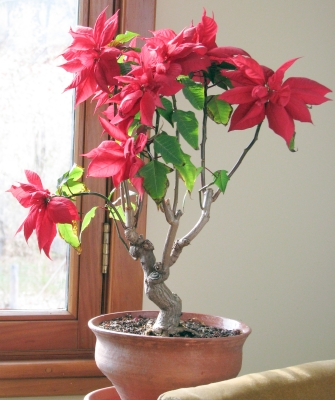
Let’s share some botanical lore of this plant by setting your holiday poinsettia on a table in good light for a close look at its flowers. I say “close ” because the flowers are not those large, red, leaf-like structures. The large, red, leaf-like structures are just that — leaves, albeit modified leaves called bracts. The bracts attract pollinating insects to the plant.
The actual flowers of the poinsettia, which are not very showy at all, originate within the small, greenish, cup-shaped structures you see above the bracts. These cup-shaped structures are “cyathiums.”
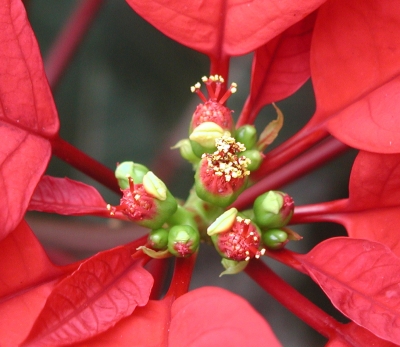
Each cyathium contains a single female flower surrounded by a harem of males. Pluck a cyathium from the plant, take a sharp knife or razor, and slice it in half from top to bottom. A magnifying glass helps now. You’ll see that the inner wall of the cyathium is lined with numerous tiny flowers which, when the flower is mature, protrude up through the opening of the cup. These are all male flowers.
Look very carefully and you’ll also see a stalk attached to the very bottom of the cyathium, protruding up through the cup opening, and capped by what looks like a turban. That is the single, female flower, which, to promote cross- rather than self-pollination, emerges from the cyathium after male flowers begin to shrivel. Cross-pollination promotes genetic diversity for healthier plants.
In addition to the male and female flowers, on the outside of the cyanthium is a single yellow gland that looks like the mouth of a fish poised to ingest food.
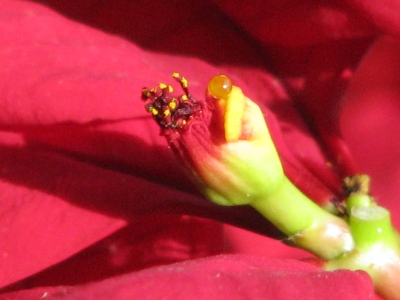
Next time a friend comments on the beauty of your poinsettia flower, take out a magnifying glass and closely examine a few cyathiums before looking up and agreeing nonchalantly.
Fool the Plant
Have you ever wondered how stores always manage to have blooming poinsettias for the holiday season?
Poinsettia, along with chrysanthemums and most strawberry varieties, is a “short-day” plant. Short-days induce “short-day” plants to form flower buds. (In reality, plants are responding to long nights, but the phenomenon was originally thought to be daylength dependent, and the term “short-day” plants has stuck with us.) Poinsettia can be fooled into blooming at any time of the year merely by exposing it to artificially shortened days.
To secure blooming plants for this past holiday season, poinsettias grown in large commercial greenhouse ranges were covered with a shade cloth so that they experienced 14 hours of darkness each “night” beginning around September. After 8 weeks of this treatment, they formed flower buds which became fully developed just before the holiday season.
You Do It
You can do this at home to make this year’s poinsettias bloom again whenever you want. Your poinsettias first will need a rest period. Loss of leaves and fading flowers indicate that your plants are entering dormancy. (Even tropical plants, such as poinsettia, do take a short, mild annual rest.) When the plants become dormant, move them to where it is cool. Water them infrequently, just enough to keep their stems from shriveling.
About April, the plants will be ready to start growing again. Cut the stems back to a few strong shoots, each about 6 inches long. Give the plants sun, warmth, and water. New shoots will push forth from dormant buds. When warm weather has settled, you can put the plants outside.
As temperatures cool in late summer, bring the plants indoors to a sunny window. Keep them away from cold drafts, which would cause their leaves to drop.
Now for the photoperiod treatment. Beginning three months before you would like the plants to bloom, make sure the plants get 14 hours of darkness each night. Moving them into a dark closet or covering them with a paper bag are convenient ways to do this.
The dark period each night must be uninterrupted. Even peek at them with a flashlight at midnight will have them acting as if they had a short night, instead of the needed long night.
After 8 weeks of the above treatment, move the plants back to their sunny window. Flower buds should be evident, and you should have blooming poinsettias within a month. If you want bloom for the holiday season next year, start the photoperiod treatment about the middle of September.
Poisonous?
Poinsettia, Euphorbia pulcherrima, is a member of the Euphorbiaceae family, commonly called the Spurge family. A common characteristic of plants in this family — which includes Hevea braziliensis, tapped commercially to make rubber — is the milky sap they exude when cut. The sap has often been considered poisonous and was sometimes used medicinally as a purge (hence “spurge,” from the French word espugier, meaning to purge). But, as Philippus Aureolus Theophrastus Bombastus von Hohenheim, more commonly known as Paracelsus, wrote in the 15th century, “All things are poisons, for there is nothing without poisonous qualities. It is only the dose which makes a thing poison.”
In fact, the sap is only mildly poisonous to humans and other animals. It can cause a rash on the skin or mouth, and stomach upset. So go ahead and nick the stem of your poinsettia and see the milky sap exude. No need to touch it.
ALMOST LIKE SUMMER
/17 Comments/in Flowers, Fruit, Houseplants, Vegetables/by Lee ReichFresh Veggies
When I was a child, it seemed that winter vegetables were mostly peas and diced carrots, conveniently poured frozen out of plastic bags into pots of boiling water. Yuk! Winter notwithstanding, my backyard garden still offers plenty of fresh winter vegetables. Let’s have a look. Kale, of course, looks unfazed by snow and plummeting temperatures. Not only does it look unfazed; it also tastes very delicious.
More surprising is the endive that I planted back in August, then covered beneath a “tunnel” of clear plastic and slightly insulating row cover held aloft by metal hoops in late October. Temperatures about a week ago went as low as -8° Fahrenheit! Thanks to the additional insulation from almost a foot of snow, now melted, the endive is still lush and tasty.
The rest of winter’s fresh garden vegetables are not in the garden. Most are in plywood boxes in cold storage, first in my mudroom, then moved out to my cooler. 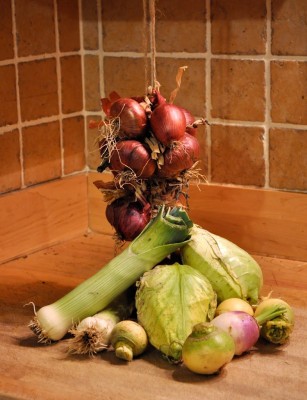 (The cooler is an insulated room cooled with an air conditioner that has been tricked, with a device called CoolBot, into bringing the temperature down just below 40° F.) One box houses Hakurei turnips, Watermelon radishes, and Daikon radishes picked around the middle of December.
(The cooler is an insulated room cooled with an air conditioner that has been tricked, with a device called CoolBot, into bringing the temperature down just below 40° F.) One box houses Hakurei turnips, Watermelon radishes, and Daikon radishes picked around the middle of December.
The same day I pulled the turnips and radishes, I also dug up leeks, now nestled into another box. With snow cover, both leeks and turnips probably would survive winter out in the garden, but reaching into a box is easier than chopping through ice and snow out in the garden to get at these vegetables.
Yet another box has a few heads of cabbage, also harvested that day in December. Lopping off the outer leaves, which anyway were looking ragged and slug-eaten, cuts water loss from the tight heads and keeps them fresh. One more box is packed full of napa type Chinese cabbages, good for “Asian slaw” or stir fry.
Most years I would have braids of onions also. Not this year. Crop failure. All the onions, both direct-seeded and grown from my transplants, didn’t grow large enough to bother storing. The problem was a clog, too long undetected, in the water line to the seasonal irrigation pump at, evidently, a critical time in onion bulb development.
(I also have a 400 square foot greenhouse packed full of fresh, growing lettuce, mustard greens, arugula, celery, claytonia, kale, chard, and mâche, with a little fresh dill, cilantro, and parsley. But that’s a whole other story.)
Summer Berries
I may be addicted to blueberries. I now eat them pretty much every morning year ‘round. That’s fresh blueberries beginning at the end of June, and frozen ones from mid-September on. I pace myself. The frozen blueberry season opens with about 70 bags (each bag about 5 cups) in the freezer, enough to keep us “berry happy” on into June.

I highly recommend planting blueberries. They are easy to grow organically, the plants are beautiful, and the berries are very healthful and taste great. They’re also easy to freeze: Just spread them on a tray until frozen, then pack them into bags. Their two main requirements are suitable soil, easily made so, and protection from birds, with netting. Each bush will net you 8 pounds, or more, of berries.
Thawed in the refrigerator, the berries taste as good as fresh ones. Or maybe I believe that only because in late December it’s been so long since I’ve had a fresh blueberry.
Olfactory Romance
Man cannot, of course, live by bread alone. I could use some fragrance, some olfactory hint of spring — or summer, or fall. Years ago, I grew “many-flowered jasmine” (Jasminium polyantha). A misnomer for my plant. Its fragrance was heavenly but it only coughed up a few blossoms each winter, despite my subjecting it to a period of temperatures below 60 degrees F. and some drought to give it a rest before it (was supposed to) burst into flowering abundance.
Gardenia was another one of my plants for winter fragrance. It did bloom in winter, late winter, and its fragrance was heavenly. But it proved to be a magnet for scale insects, one of the most difficult house plant pests to control organically. Both plants have long ago been composted.
I’m now eagerly awaiting blossoms on my Meyer lemon plant. The plant is easy to bring into bloom, and there’s the added bonus of delicious lemons. Being a hybrid of lemon and sweet orange, Meyer lemon has a slightly different flavor from that of lemons.
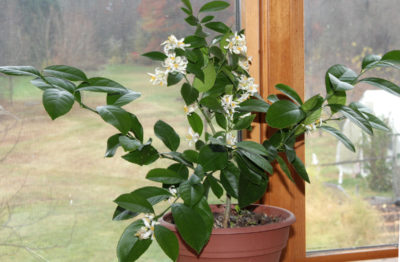
The other plant to — reliably, I hope — blossom now, in early winter is sweet osmanthus (Osmanthus fragrans), specifically the variety Goshiki. Why Goshiki? Because it has variegated leaves, green and white with splashes of pink, spiny like those of holly. 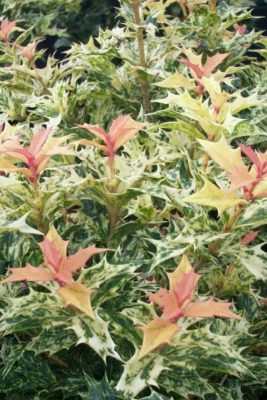 It’s cold-hardy to Zone 6. My plan is to grow it in a pot to bring indoors to a cool sunny window in late fall to spend the winter.
It’s cold-hardy to Zone 6. My plan is to grow it in a pot to bring indoors to a cool sunny window in late fall to spend the winter.
This is all a pipe dream so far because all I have is a spindly stem I cut to root from a plant beckoning me from a sidewalk near Philadelphia. The cutting doesn’t look hopeful. The quest begins.
SNOW’S COME AND SO HAS FRUIT
/8 Comments/in Fruit, Soil/by Lee ReichFree and Attractive Mulch
Beautiful. Floating down from the sky. A white blanket of “poor man’s manure.” That’s what gardeners and farmers have called snow.
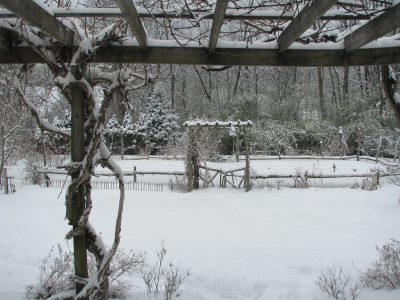
In fact, snow does take some nitrogen from the air and bring it down to ground level for plant use in spring. Not that much, though. Just a few shovelfuls of real manure could supply the same amount of nitrogen as a blanket of snow.
Mostly, what I like about the 15 inch deep fluffy whiteness now on the ground is the way it insulates what’s beneath it. Fluctuating winter temperatures wreak havoc on plants, coaxing them awake and asleep and awake and asleep as air temperatures go up and down and up and down. Each time plants are awakened, they become more susceptible to subsequent cold, the whole problem exacerbated with borderline hardy plants.
Anticipating cold weather and snow, last fall I cut back a cardoon plant and two artichoke plants, covered each with a large, upturned plastic planter, and then smothered everything in autumn leaves. 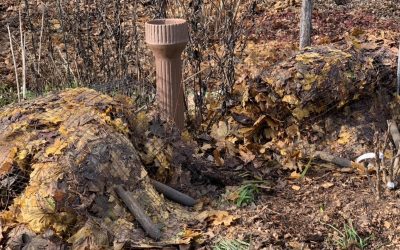 Both kinds of plants are probably cold-hardy to about zero degrees Fahrenheit, but here winter temperatures, except last winter, typically drop to about minus 20 decrees Fahrenheit. That snowy blanket provides extra protection that the plants might need — especially after last Saturday’s unseasonal low of minus 8 degrees.
Both kinds of plants are probably cold-hardy to about zero degrees Fahrenheit, but here winter temperatures, except last winter, typically drop to about minus 20 decrees Fahrenheit. That snowy blanket provides extra protection that the plants might need — especially after last Saturday’s unseasonal low of minus 8 degrees.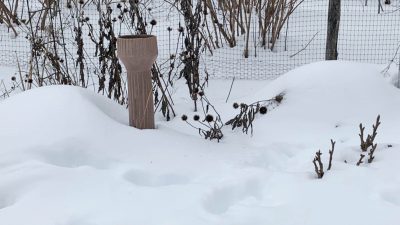
Hardy orange (Citrus trifoliata) is another plant to benefit from snow cover. It’s a Citrus that’s allegedly cold-hardy into zone 5 (-20°F minimum temperature). I planted some seeds outdoors a few years ago and, while their roots survive winter cold, the tops die back to resprout each spring. I also planted out a more mature hardy orange that was given to me; it also suffered some cold damage.
The deeper this winter’s snow and the longer it stays deep, the more of the hardy oranges’ stems will survive till spring. Perhaps, helped along with global warming, enough of the above ground parts of the plants will survive to reward me one year with sweet-smelling blossoms and, less appealing, their very puckery fruits.
Multiplying Currants and Grapes
Last fall, I cut stems from my black currants and grapes into 8 inch lengths. In the bare ground between some dwarf apple trees, I scratched some lines and pushed a straight-bladed shovel into the ground on that line. Levering the handle of the shovel opened up just enough space in which to shove one or two of those cut stems, distal ends up, right up to their topmost buds. Then I moved along the scratched line, pushed the shovel in again, shoved in more stems, and so on down each line. If all goes well, each of those stems will grow into a good sized plant that I can dig up and transplant next autumn.
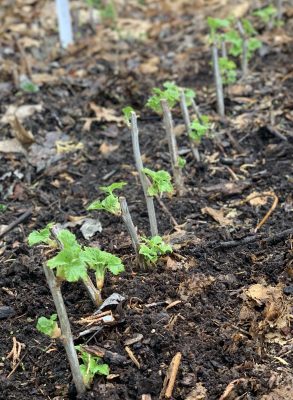
That is, unless alternating freezing and thawing of the soil heaves those stems up and out of the ground. I’ve seen it happen, leaving a row of carefully inserted stems sitting on top of the ground by winter’s end.
All of which is another reason I’m thankful for the snow. In addition to protecting plants from cold, the blanket modulates soil temperatures, keeping cold soil cold, which is how I’d like it to remain until spring. I could have — should have — thrown some fluffy, organic mulch, such as leaves or straw, over the stems to do the same thing. But I didn’t. I hope the snow stays.
Where One Plus One Does Not Equal Two, Figuratively Speaking
The harvest has begun: I picked the first fruit of the season this week. Not only that, but it was the first fruit I harvested from the particular plant. The fruit was a Sunquat, planted in a pot a year and a half ago. It summers outdoors and winters indoors, basking in sunlight streaming through a south-facing window.
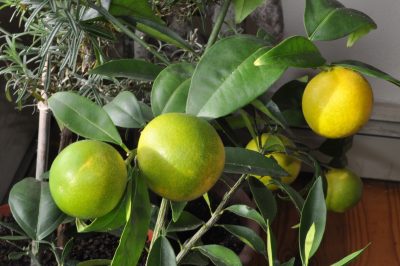
Not many people have heard of Sunquats. I hadn’t. Citrus plants hybridize freely and Sunquat is one of many citrus hybrids, this one a mating of kumquat (Citrus japonica) and Meyer lemon. I happen to be a big fan of the tart flesh and spicy, sweet skins of kumquat fruits. I also happen to be a big fan of Meyer lemon, which is not a true lemon but is probably a hybrid of lemon and sweet orange.
Meyer lemons are juicy and somewhat sweet, with a flowery aroma. They also bear prolifically. As testimonial to their precocity, I once had a cutting that flowered soon after rooting, when it was only a few inches tall.
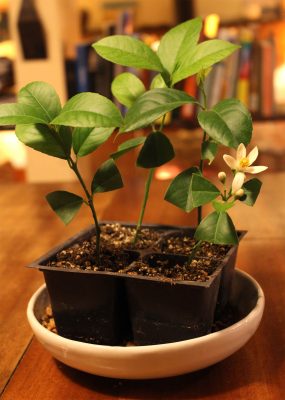
So what could be bad about combining kumquat and Meyer lemon? A Sunquat! The skin was sour without picking up any of the spicy tang of a kumquat’s skin. The flesh was much less puckery than kumquat or lemon, but was uninteresting, just bland. Perhaps harvesting a bit underripe, before the skins turn full yellow, will put some pizazz in a Sunquat.
If not, I’ll stick to growing Meyer lemons and kumquats, each on their own and with their own delectable flavor.
